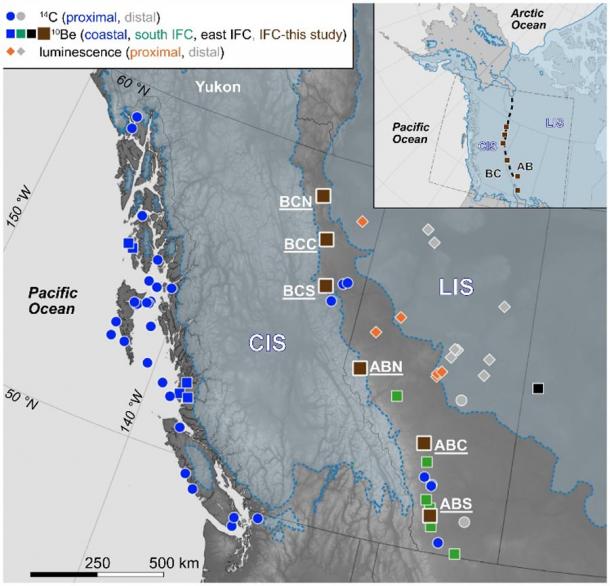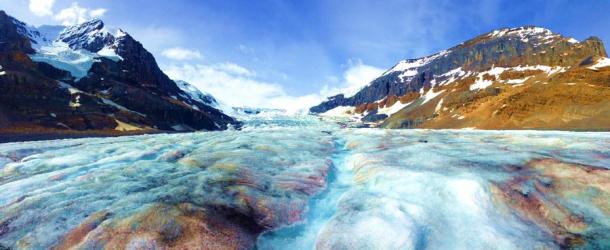A long-standing debate about the peopling of the Americas has been whether the first humans arrived there over the Siberia-Alaska land mass called Beringia or by traveling along the Pacific coast in small boats. Now, a new study published in the Proceedings of the National academy of Sciences (PNAS) has examined whether an ice-free corridor was available along the Beringia route for travel from Asia to the Great Plains of North America at the time of the first human migration. It has found that until around 13,800 years ago, a gigantic 3,000-foot-high (914-meter-high) ice wall blocked the land route. This means the sea route was the only one available to the earliest migrants until 13,000 years ago when the massive ice wall melted.
The international research team, led by Oregon State University geologist and archaeologist Jorie Clark, tried to settle the debate around when and how the first human settlers reached North America by arriving at a precise dating of the ice-free corridor, reports ATI.

The latest study focused on when the massive North American ice wall was present and when it wasn’t and how this would have implicated human migration in terms of being able to use any land route until about 13,000 years ago when the wall receded. This map shows the extent of Cordilleran and Laurentide Ice Sheets after the initial opening of an ice-free corridor 13,000 years ago, and the location of rock samples taken to prove their theory. ( PNAS)
How The Ice Wall Theory Changes The Clovis Story And Others
The question about land or sea migration really depends on when the first humans arrived in the Americas. For long, it was believed that the Clovis people , a prehistoric Paleoamerican group of hunter gatherers reached North America from Siberia around 13,500 years ago along an inland ice-free corridor (IFC) that formed after the last ice age. The Clovis derive their name from their distinctive stone tools first found near Clovis, New Mexico, in the 1920s.
However, recently scientists have uncovered evidence of human presence in the Americas that long predates the Clovis. According to Live Science , in 2021, 60 ancient human footprints were found in New Mexico , dating to 23,000 years ago. And in 2020 stone tools dating to about 26,500 years ago were excavated in central Mexico. At this time, Beringia would have been covered by a massive ice wall blocking the way of would-be migrants who would have been forced to turn to the sea to reach North America .

This glacial would have been easy enough to hike over but that’s because the almost kilometer-high (0.62-mile-high) ice wall had melted and that was only 13,000 years ago. So how did humans reach the Americas and leave artifacts that go back to 20,000-25,000 years ago? ( erikakirky / Adobe Stock)
The Ice Wall and IFC Theory Leans Towards Sea Travel
The land route hypothesis rests on the dating of the ice-free corridor (IFC) along the Rocky Mountains . To understand when exactly migrants may have begun using the land route, Clark and his team took 64 geological samples from six locations across 745 miles of where that corridor supposedly once existed in what is now British Columbia and Alberta. By looking at the radioactive elements in these rocks, they determined how long they had been exposed to the sun.
“We used a method known as cosmogenic nuclide exposure dating, which is a ‘rock clock’ that essentially tells us how long rocks have lain exposed on Earth’s surface – after a glacier has retreated and left them behind and uncovered, for example,” said co-author Louise Guillaume according to the Daily Mail .
Clark told Live Science that they found that prior to about 13,800 years ago, the region would have been covered by huge ice sheets that “may have been 1,500 to 3,000 feet (455 to 910 m) high in the area where they covered the ice-free corridor…. We now have robust evidence that the ice-free corridor was not open and available for the first peopling of the Americas.”
Earlier research has suggested that the ice-free corridor opened around 15,000 years ago. The findings of Clark’s team push this forward somewhat but this relates to when the corridor was “fully opened.”
The researchers add other caveats as well. They clarify that they aren’t suggesting that the ice-free corridor wasn’t used for human migration at all, only that it wouldn’t have been available to the first human migrants to the Americas to use. Clark said that later waves may have taken the more direct land route once the corridor opened up.
“We have closed the door on the ice-free corridor. This research makes it clear that the corridor wouldn’t have been available as a migration route back when people first entered the Americas some 2,000 years earlier, putting the Clovis First theory to rest,” stated study co-author Dr Dylan Rood from Imperial College London categorically, according to Daily Mail .
Clark cautioned though that a lot more needs to be learned about whether the first migrants actually used the coastal route , and if so, what kinds of craft they traveled in. To shed further light on the earliest waves of human migration to the Americas, archaeological sites from the migration route need to be discovered.
Top image: Top Of The Glacial ice wall. Source: Ramunas / Adobe Stock
By Sahir Pandey


